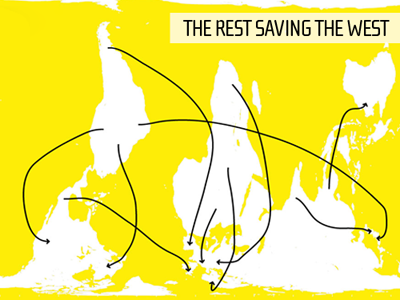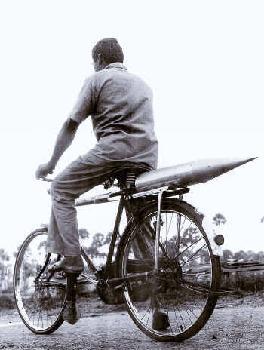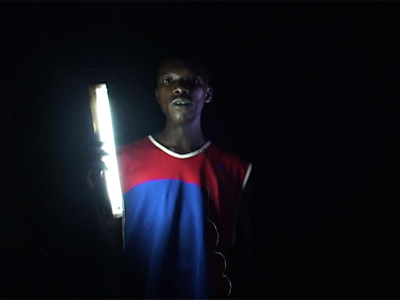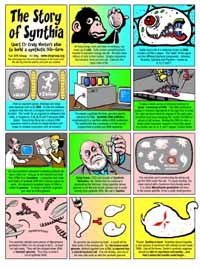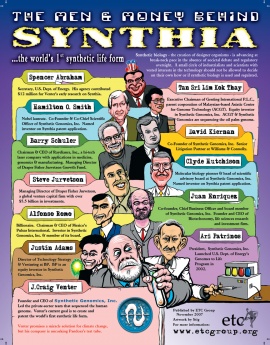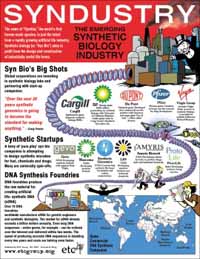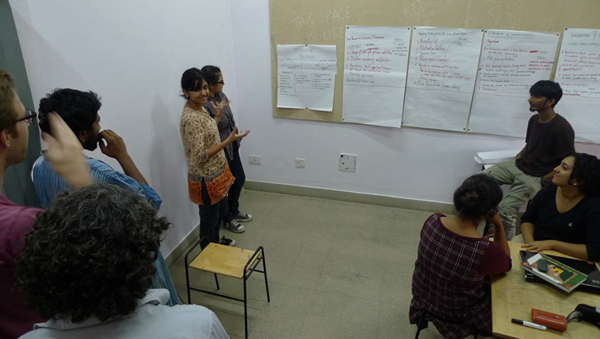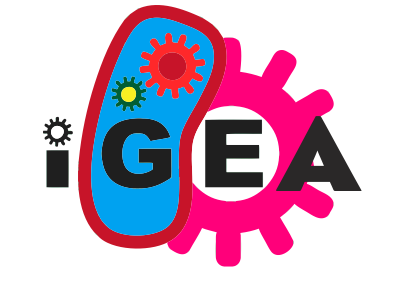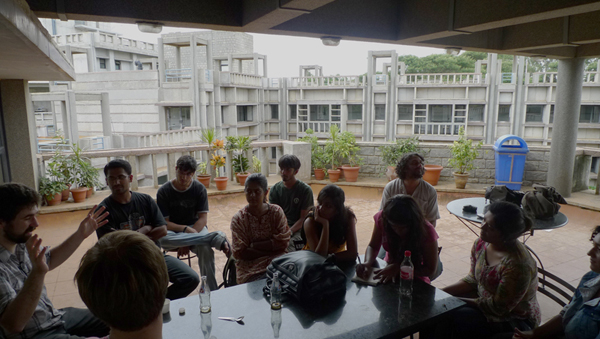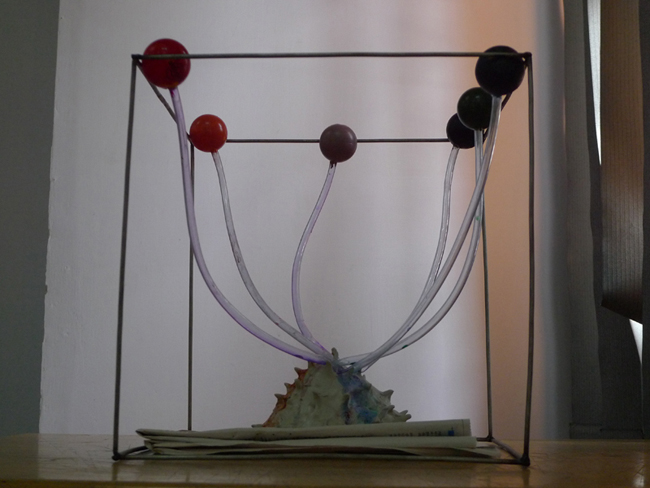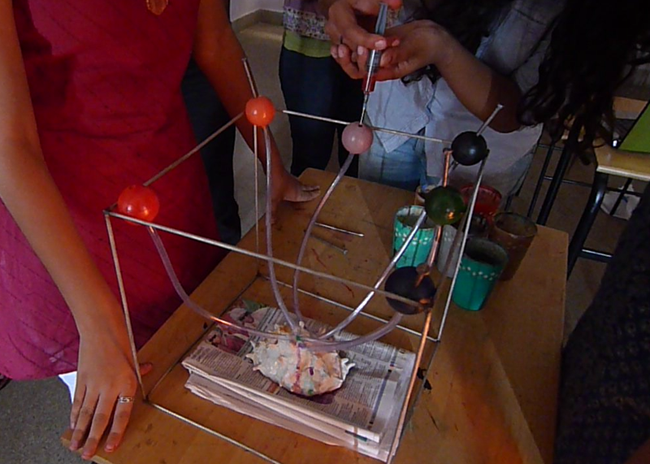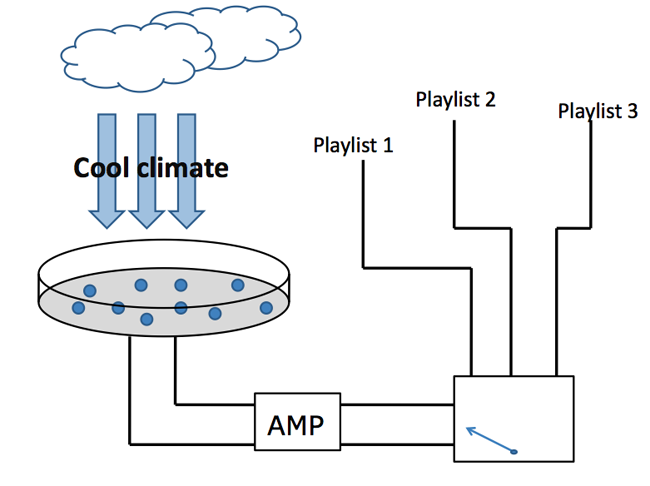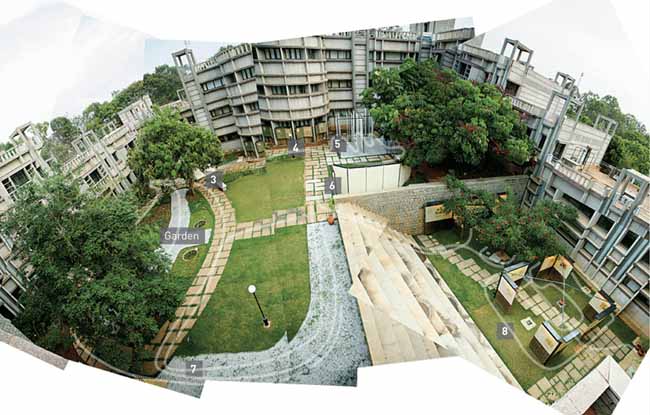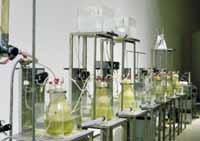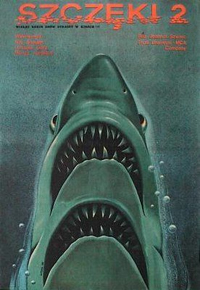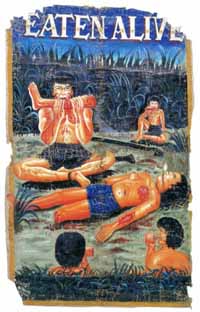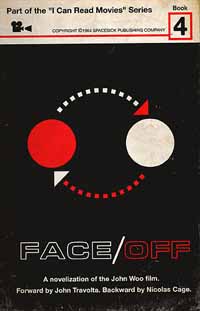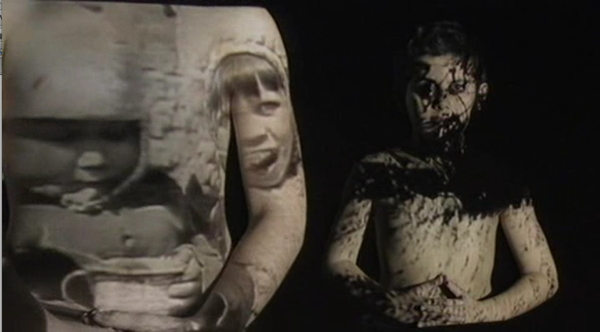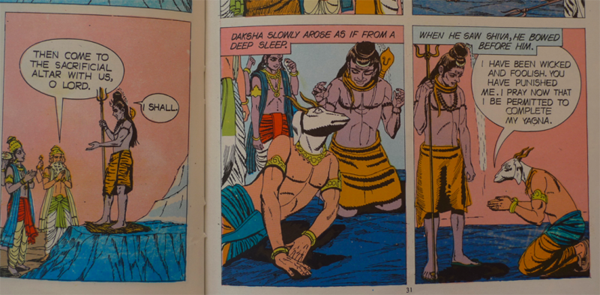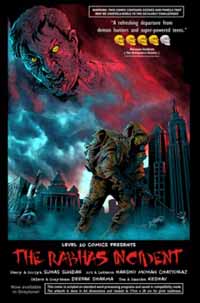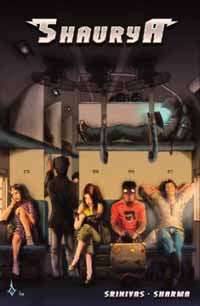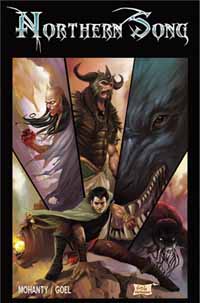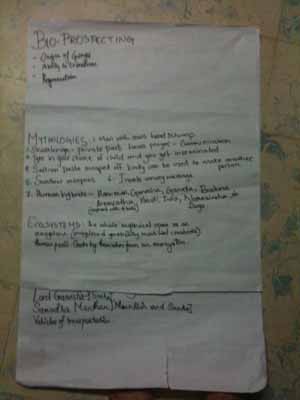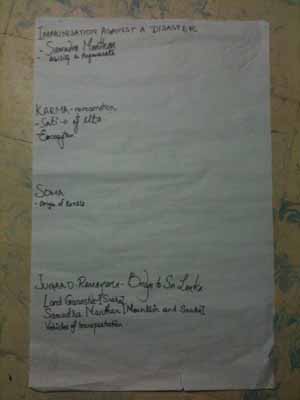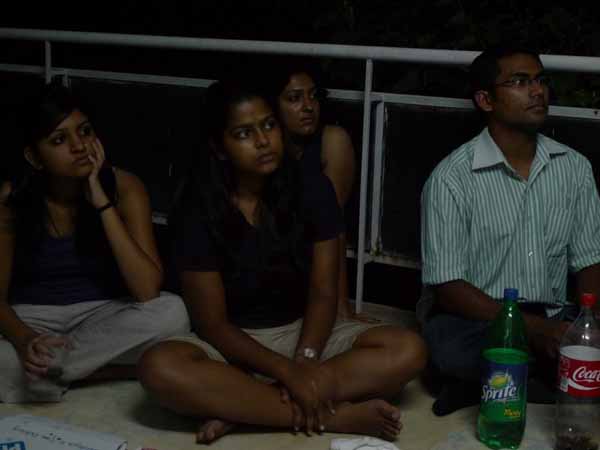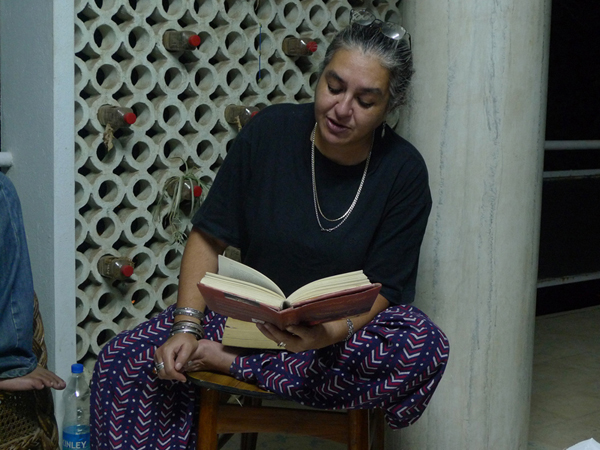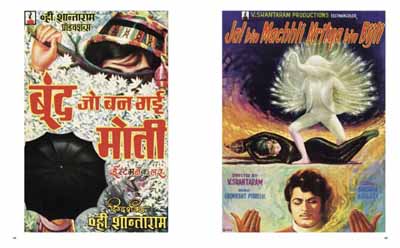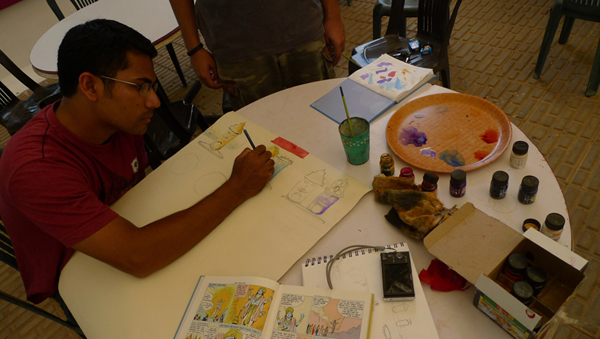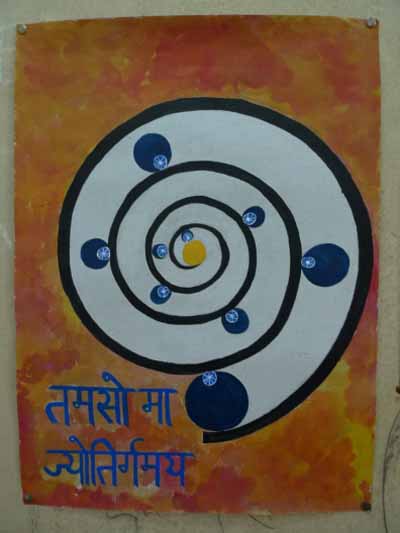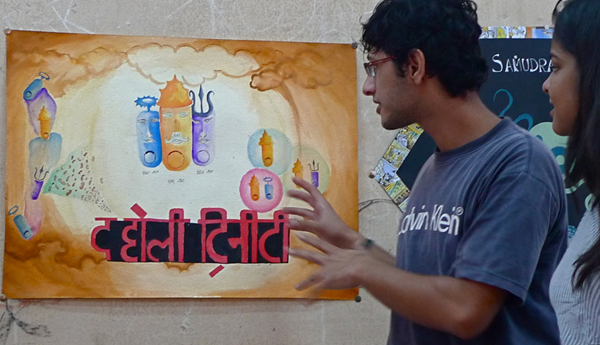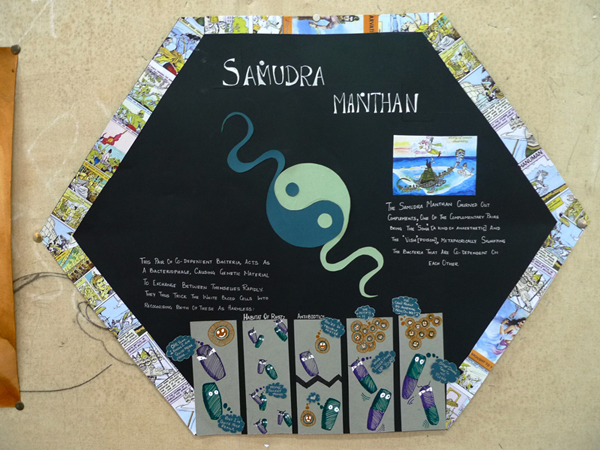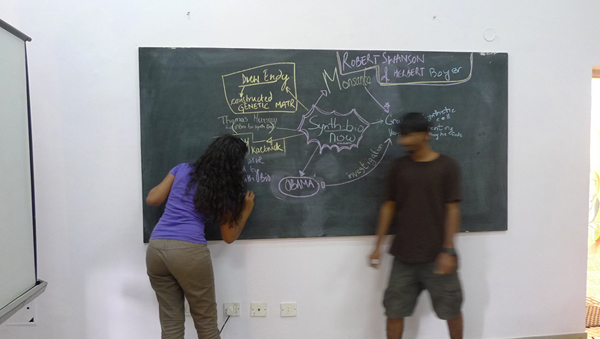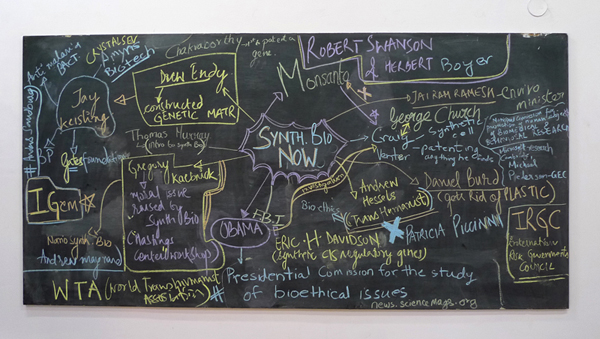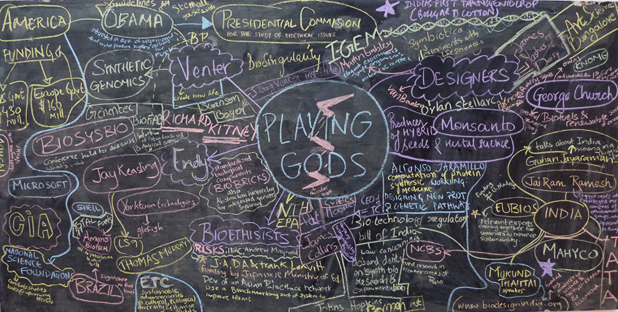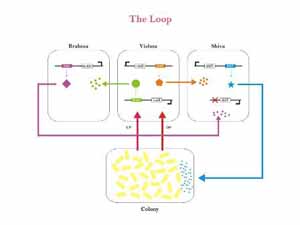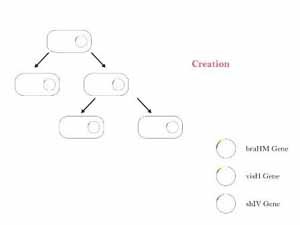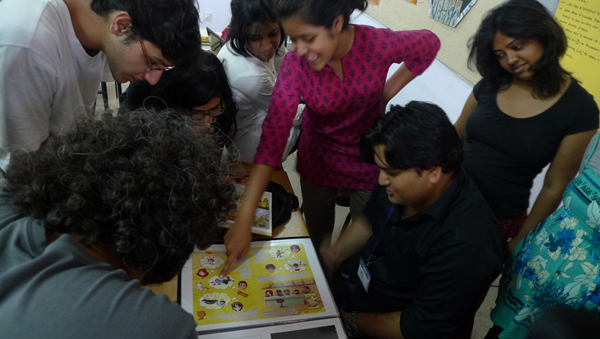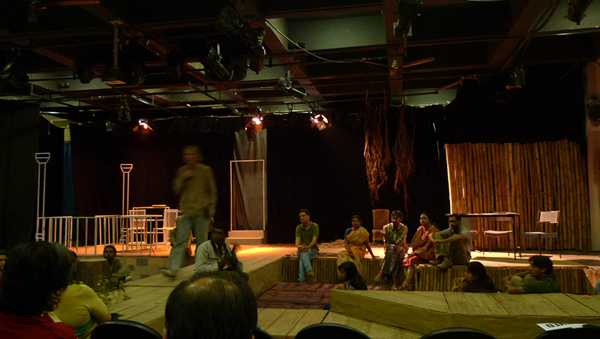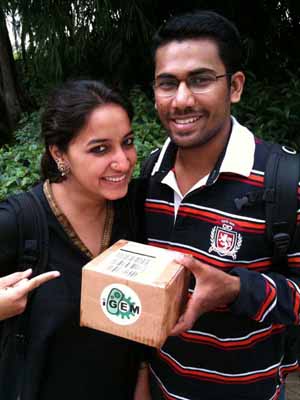Team:ArtScienceBangalore/NoteBook
From 2010.igem.org
This page documents the art/design workshop run by [http://www.daisyginsberg.com/ Alexandra Daisy Ginsberg] and [http://james-king.net/ James King] with [http://www.thedepartment.in/ Yashas Shetty] and the [http://hackteria.org/wiki/index.php/People ArtScienceBangalore iGEM 2010] team.
We've joined for two weeks to help the team generate ideas for iGEM 2010 (James is here longer). This week, we're exploring the role of art and design in synthetic biology and iGEM, and trying to generate new ideas about what this contribution might be!
[http://www.flickr.com/photos/jamesking/sets/72157624301462124/ James' flickr] [http://www.flickr.com/photos/alexandradaisy/sets/72157624181867815/ Daisy's flickr]
Monday 14th June: Reverse Engineering Workshop
Day 1 started with the team showing us what they've been up to the last three weeks.. an amazing journey from the history of microbiology to DIY lab equipment (including an incredible 7000rpm hand-held centrifuge made from an egg beater) to visits to the National Center for Biological Sciences.
We showed our work with other synthetic biologists, covering topics such as the difference between natural and synthetic forms of life, the promise and compromises of synthetic biology, new manufacturing processes, iGEM and finally the way that the concept of life might change due to synthetic biology.
As a group of artists and designers competing in a competition set up for engineers and scientists we need to think about how we can make a meaningful contribution without emulating the approach of science-based teams. As a group we found we were skeptical of the engineer's view of biology and wanted to explore alternative visions and ways of manipulating life. What would be the reverse of engineering?
The Rest Saving the West
Quite a few of the projects of previous iGEM teams are aimed at providing solutions for Third-World problems: Bacteria that detect arsenic in drinking water or cadmium contaminated food and bacteria that kill mosquitos larvae. Very few iGEM projects aim to solve first-world problems, such as Todai Tokyo's attempt to tackle lifestyle diseases.
So we asked the team to imagine they were entering the rather wonderful [http://designforthefirstworld.com/ Designs for the First World competition] as a team of tongue-in-cheek Synthetic Biologists from India trying to solve the problems plaguing the West:
- Food Production and Eating Disorders
- Aging Population and Low Birth rate
- Immigration and Integration to Society
- Sustainability and Over consumption
After a group brainstorm the team came up with loads of ideas, highlights are below:
Food Production and Eating Disorders
- Bacteria Salad - Bacteria that has the flavour and consistency of food but with none of its nutritional value - just like salad.
- Moo.coli - Bacteria that replace cows in milk-production.
Aging Population and Low Birth rate
- The Booster Cell - a cell with packed with mitochondria that latch onto the cells of the host organism (in this case, old people), giving them more energy.
Immigration and Integration to Society
- Coloreria - Melanin controlling Bacteria.
- Testosterone reducer - Bacteria that reduces and regulates testosterone in men, thus controlling crime in society.
Sustainability and Over consumption
- Purgcaelum - Bacteria that filters pollution
- A bacterial substitute for wood
Tuesday 15th June: Jugaad Biology
The first Indian rocket was transported to the launch site by bicycle. [http://www.hinduonnet.com/thehindu/mp/2002/11/18/stories/2002111801050200.htm source]
[http://en.wikipedia.org/wiki/Jugaad Jugaad vs. Hack]
"Jugaad is a survival tactic, whereas a hack is an intellectual art form; i.e. Jugaad is the wile of the poor, and hack the pastime of the affluent cerebral. Jugaad is a hack to get around or deal with a lack of or limited resources, and has a class component to it - jugaad are things poor but clever people do to make the most of the resources they have. They do what they need to do, without regard to what is supposed to be possible."
A new paper by Maureen O'Malley at Exeter University describes synbio as a 'kludge': [http://www.mitpressjournals.org/doi/abs/10.1162/BIOT_a_00006?journalCode=biot Making Knowledge in Synthetic Biology: Design Meets Kludge]. A kludge is
an ill-assorted collection of parts assembled to fulfill a particular purpose - it's a bit like jugaad, a new word James and I learnt today. We watched [http://csides.net/2009/wordpress/?page_id=332 Kempinski], a mysterious science fiction short. Simple and shot on a very low-budget, Kempinski is a documentary of a future somewhere in Africa, its realistic inhabitants living in a strange mystical world. The interviewees discuss their existence showing the only artifacts of this other realm - fluorescent strip lights - somehow imbued with animist power.
This morning, we looked at the ways synbio might be hacked in unexpected ways. Starting with a talk on the Promise and Peril in Synthetic Biology, we discussed the social, ethical and cultural issues raised by synbio. We discussed synbio hype, who benefits, and the critics of synbio. With the BP oil spill and Bhopal Gas Tragedy in our minds, what might the synbio version of engineering failure be? What is the grey area between the disaster of bioterror/bioerror, or the perfect sustainable future we're promised?
This is the list we all came up with:
- Bioterrorism
- Bioerrorism
- Irresponsible Promotion: Artists irresponsibly appropriating technology - lack of criticality?
- Creating Monsters... bad design
- Destruction of natural ecological networks – foreign species
- Bandwagon – throwing money at inappropriate technology and solutions? (Global rather than local solutions/politics)
- Blind Faith: Making it just because you can, not questioning why doing it – new farmed-out mass technology is a synbio lab.
- Environmental disaster… things escape that are fine in the lab, that reproduce
- Synbio’s Paradox It’s safe because it can’t escape and isn’t robust outside the lab. Yet we have applications that will be put into the environment!
- Intellectual Property who owns the technology. Should corporations be allowed to patent DNA? Are we making something new – so that can be patented?
- Is their interest the community? Who will control the licensing?
- Bioprospecting taking things from nature and commercializing them
- Give and Take How can people be compensated – how to create a sustainable industry?
- Rate of Change Can policy and law keep up with the rate of change of technology
- Just because we can make it, should we?
- How do you govern it?
- Priority How do we prioritize what we want, where we want it?
- Unexpected wars… War because Middle East’s oil is no longer wanted!
- Getting left behind will everyone have to do it
- Increasing the imbalance Anti-malarials and fuel for the third world made in the Midwest.
The lone critics, the ETC group made these [http://www.etcgroup.org/en/materials/cartoons posters] which we looked at:
News at One
The team split into groups of three, each selecting an iGEM project from any of the competition years, to imagine unexpected, unintended uses of this technology. We asked:
- Are we in the future, the present (or even the past)?
- How is it being used in an unexpected context or manner?
- How has it been hacked?
- Who is using it?
- Is it for a good or a bad purpose?
Inspired by two episodes of American comedy news show, the Colbert Report (on [http://www.colbertnation.com/full-episodes/thu-june-10-2010-alan-bean BP] and [http://www.colbertnation.com/the-colbert-report-videos/221178/march-10-2009/jay-keasling Jay Keasling]) each team presented a news item, telling us the story of a group of people using the technology in a completely unexpected way. Mukhund came over from NCBS to watch the show.
Today on News at One
- Sticky Situation Sex before marriage at risk as Glucoli found in condoms. Concerned mothers sabotaging daughters' boyfriends thought to be culprits.
- Anarchist Amalgamation BP claims latest oil spill found to be caused by GM bacteria released by terrorists. Sequencing shows cause from multiple commercial strains. Anarchist factory workers at the heart of the outbreak.
- Hair-Raising A new technology designed to switch genes on and off is being used to combat Alopecia and premature balding. A cosmetic industry hack of medical technology causing a trend as consumers found standing under light sources before a special date to cover up bald spots and grow glossy heads of hair.
iGEA Prelims! - Afternoon workshop
Having stepped into the realm of the impossible and the sci-fi future, we wanted to bring back the idea of Jugaad Biology - the artist and the scientist using the hack or kludge.
- What is the iGEA competition - the International Genetically Engineered Art Competition?
- What categories are there?
- What prizes can be won? How do people communicate their work?
- What might be disqualified from entering?
The three competition proposals:
Samrajni, Anusha, Shreya
- Awards: Most Critical of the Social System, Most Socially Controversial, Most Influential on Pop Culture, Best Peer Review, Best Concept, Best Expressed Idea, Best Negative Emotion Evoked,Best Positive Emotion Evoked, Best Use of Colours;
- Prizes: Monetary incentives, recognition;
- Disqualification: Plagiarism, Not Breaking Biosafety Laws.
Karthik, Aaron, Sayed Represent the Concept of Life
- Awards:Best Social Critique, Best Use of Colour,Best Visual Aesthetics, Most Innovative Concept, Best Pattern & Texture, Most Thought Provoking, Best Abstract Work, Most Eco, Gestalt Award;
- Disqualification: None- everything is valid;
Mohor, Sankhalina, Akshitta Zoobotart
- Categories: Plants - Thorn-Art, Pigment Art, Flower Art; Microbes - Collage Art, Dye Art; Light Art, Movement Art
- Awards I: Modification,Installation,Concept, Aesthetics,Survival period, Static/Dynamic, Future Uses - purposeful; II: Ecosystem: With at least 3 organisms (modified) surviving
- Disqualification Criteria: Useless or useful but harmful, Survival in extreme conditions but death not accepted
Before discussing the competitions compiled by each of the three groups, we asked everyone: What do you, as artists and designers, bring to synthetic biology? A huge debate exploded!
- What are the differences and similarities between artists and scientists, their points of view, aims, boundaries, logic, constraints? What about design?
- Experimentation, subjectivity, tangibility, play, process, aesthetics? What about sensitivity and empathy?
- It's a new medium, but we don't know the limitations. Like paint, we need to mess around to learn! We've been learning the science, but we still need to break through the barrier. Scientists though tend to be constrained by what exists.
- Art as critique on society and self.
- Context - do designers have a broader approach than scientists who need deep knowledge?
- Art and science both exploring questions? Both can explore things the unconventional way.
- Is the end product or the process our priority? In science, is the end product the priority?
- Bad science, bad art...
- Plagiarism - is recombinent DNA plagiarising? How does open source fit in - remix culture.
- Is the difference similar to a chef making molecular gastronomy and a scientist engineering food?
We compiled the discussion into the ideal art/design iGEM competition.
Ready for the launch tomorrow... Could scientists enter iGEA to subvert it?
Wednesday 16th June: Welcome to iGEA 2010
iGEM started as class at MIT in 2003, evolving into an international competition. Today at Srishti we're launching iGEA, - The International Genetically Engineered Art competition - the art and design sibling of iGEM.
Powered by synthetic biology, iGEA explores how this emerging technology can be used for art and design purposes.
DNA parts submitted by teams to the Parts Gallery - an Open Source biological media library - may be used in new art and design works, and even by scientists...
We are an open source platform created to enable artists and designers to find new uses for synbio, to create new discourse about the science, and for implementing and exhibiting your creative projects at the interface of art and science.
Yesterday, we spent the afternoon designing the new competition, the awards and rules.
The Awards
- Best Ecosystem
- Best New Emotion
- Best Social Critique
- Best Pop-Culture
- Shooting Star (short-lived, burning bright)
- Remix Culture
- GRAND PRIZE: Gestalt Award
- Critics Choice for Visual Aesthetics
- Genetic Raspberry Award
Today, we're running the inaugural iGEA with 3 teams.
The competition rules:
What does your organism do, how did you make it, what is its impact, why does it fit in the category, what new parts did you have to make?
Make an art/science poster for your iGEA entry. What is an art/science poster?
To describe your project, you could also make artifacts, images, a film, a performance or a powerpoint to use as props in your presentation.
At the end of the day, we’ll be holding the iGEA competition presentations.
Prizes will be awarded; the Gestalt Award Winner will present their iGEA project at the National Centre for Biological Sciences tomorrow!
Good Luck!
Round 1
Combo categories were picked out of a hat by each team, and at the end of the day, first ideas were presented.
- Best New Emotion & Best Pop-Culture: Formal-in Culture Aaron & Sayed
Ants secrete and detect formaldehyde in order to structure the behavior of their colony. In order to manipulate the culture of an ant colony, Aaron and Sayed suggested that a bacteria could be engineered to inhibit formaldehyde production in ants: making the ants more individualistic.
- Best Ecosystem & Shooting Star: [http://en.wikipedia.org/wiki/Yuga Yuga] Bacteria (aka PastPresentFuture Bacteria) Akshitta, Shreya & Anusha
Imagining a Hookah as an ecosystem, this team proposed to engineer a bacteria that produced powerful psychotropic drugs that could be inhaled and that would present visions of the past, present and the future.
- Best Social Critique & Remix Culture: DNA Remix Karthik, Farhad, Mohor & Samrajni
This group proposed a future in which humans have learned to modify their biology, remixing the parts of other animals into their bodies. Wings for transport and shells for shelter.
Thursday 17th June: On Tigers and Small Disasters
A discussion on designing from our local, personal perspective as opposed to global was an interesting precursor to our visit to the National Centre for Biological Sciences (NCBS).
We presented along with Zack Denfeld to the NCBS scientists, Srishti staff and an interesting mix of academics and NGO's. The team had the mixed pleasure of hearing the talks again (sorry!) but in a new context: inside the scientific establishment. Did we change the way we spoke? What kinds of critique did we encounter from the NCBS scientists? The discourse continued in the NCBS garden with the scientists, amongst spice plants curated as part of an exhibition on historical bioprospecting, [http://www.ncbs.res.in/hortus/hortus.html Such Treasure and Rich Merchandize].
In the afternoon, with a view over NCBS, we discussed as a group. How do we feel about technology and what happens when it fails? After these last few weeks, how does everyone feel about synthetic biology? Some interesting points about the social constructs around science were raised in the morning presentations, like the example of a GM wheat introduced into India that failed - women were uncomfortable kneading it as the ground grain texture wasn't right to make local foods.
Should we just accept it and move forward? Can we deny progress? An interesting idea was raised - that we can only learn about how to handle a technology by a failure, perhaps even a small one, effectively 'inoculating' society against future grand disaster. So what is a small disaster? Deepwater Horizon is a certainly a grand oil disaster, despite countless previous spills.
Zach got controversial: tigers! With just 1444 left, could a bacteria be engineered to specifically target these national treasures? So rare, their loss wouldn't have much impact on the ecosystem, but it would raise huge debate about what we want from a technology. 'Cute megafauna' touched our hearts more than the extinguishing of the sun.
iGEA day 2
Back to Srishti to work on the iGEA entries, this time, to develop a bacteria within the realms of the scientifically possible. Each group has to make an artifact and represent it in a film to tell the story of the iGEA bacteria. Developing the ideas from Wednesday, each group kept the same categories.
- Best Ecosystem & Shooting Star (short-lived, burning bright)
- Best New Emotion & Best Pop-Culture
- Best Social Critique & Remix Culture
The film should illustrate the working of the BioBrick in particular and organism in general, using existing BioBrick terminology.
The idea can be wild, but the science must be possible in 2010!
Friday 18th June: Telling Tales
Model of the Glandotransius
This morning, the iGEA teams presented their films and artifacts, made since last night!
The Glandotransius Akshitta, Shreya & Anusha
The Glandotransius is an engineered E.coli that stimulates various glands in the human body. It accentuates the effects of certain hormones. It produces DMT, [http://en.wikipedia.org/wiki/Dimethyltryptamine Dimethyltryptamine], a chemical produced by the pineal gland, found in almost all plants and mammals and a hallucinatory, dangerous drug. The Glandotransius stimulates the ecosystem of the various glands, from the testes to the hypothalamus. While the pineal gland is synonymous with [http://en.wikipedia.org/wiki/Third_eye Shiva’s Third Eye], its over-stimulation may also bring with it lack of perception leading to lack of communication, a plethora of psychological and physical problems and long term effects like permanent damage to the immune and central nervous system.
E.cloudy Mohor, Samranji & Farhad
Bacteria which help coordinate your music with the weather. E.cloudy is a Bacteria which is temperature sensitive and produces electricity. The E.Cloudy bacteria contain two existing BioBrick parts – BBa_K098995, responsible for the thermo sensitivity.(Designed by Harvard 2008 IGEM team) and BBa_K499271, responsible for the electricity (designed by Boris Kirov IGEM 2010).
Apart from being aware of the weather, it creates awareness in how two very different genes, from possibly two very different organisms have been put together to create a machine. It could lead us to questioning our rights to remix things, whether it is OK to mix the machine with living cells, and our rights to play with natural selection. Can we define this as a form of natural selection?
Formal-in Culture Aaron & Sayed
Video coming soon...
Next, a lecture on Telling Tales...
NCBS [http://www.trapeze.in/feat7_scrm.html garden] and exhibition
How are science stories told?
Yesterday, we saw the exhibition about bioprospecting at NCBS, [http://www.ncbs.res.in/hortus/hortus.html Such Treasure & Rich Merchandize], told through curated plants and images. How do other iGEM teams tell the story of their work? Harvard's Christina Agapakis has a great blog called [http://scienceblogs.com/oscillator/ Oscillator] that investigates art and design as well as synbio, this year she is running the [http://harvardigem.org/ Harvard iGEM] team, who are making a lovely wiki documenting their work. Semiconductor Film's [http://www.semiconductorfilms.com/root/Magnetic_Movie/Magnetic.htm Magnetic Movie] takes voice interviews with scientists at NASA Space Sciences Laboratory, UC Berkeley, California, talking about magnetism and gravitational field and other invisible forces, making them visible and tangible through sound and animation laid over real spaces.
Telling stories through artifacts...
Miller Urey Experiment, Cloaca, contraption from Man in the White Suit
After the great narratives told this morning, we looked at precedents of other artists and designers telling stories through objects, from tales about manufacturing and sustainability [http://www.thomasthwaites.com/thomas/toaster/page2.htm Thomas Thwaites' Toaster Project], to alternative histories - [http://www.pohflepp.com/?q=goldeninstitute Sascha Pohflepp's Golden Institute] to frame the present and future.
Noam Toran and Onkar Kular's [http://noamtoran.com/NT2009/projects/the-macguffin-library Macguffin Library] takes plot devices from films, nicknamed Macguffins by Hitchock, and collates them into a physical library, some from real films, interspersed with some of their own fiction. [http://www.designboom.com/weblog/cat/10/view/9745/olafur-eliasson-and-ma-yansong-feelings-are-facts.html Feelings are Facts], a new collaborative installation by Olafur Eliasson in Beijing creates a physical environment through mist, coloured light, and sound to tell a story.
Thinking about ecosytems, we considered Wim Delvoyes's [http://www.wimdelvoye.be/cloacafactory.php Cloaca] system in context with the famous[http://en.wikipedia.org/wiki/Miller%E2%80%93Urey_experiment Miller-Urey Experiment], which recreated the first development of life, with scene's from classic Ealing comedy [http://www.youtube.com/watch?v=fMwFxUQx1PI&feature=related The Man in the White Suit], where great sound design creates the atmosphere of scientific discovery.
Telling stories about stories
Ghanaian, Polish, contemporary parody
What about local genres? Japanese cartoons like [http://www.avclub.com/articles/spirited-away,26708/ Spirited Away] combine spiritual themes with contemporary animation. Next, we looked at film posters from around the world thinking about the art/science poster question... Ghana, [http://www.polishposter.com/html/american07.html Poland], India. What are local genres for story telling? Polish film posters sum up the entire plot in one visual play-on-words, like [http://www.jawsmovie.com/wp-content/uploads/2008/11/2514314748_4719a61242.jpg Jaws 2], a shark with two jaws. We looked at [http://spacesick.com/books.html contemporary graphic designers] playing with this genre (like the Face Off poster above, part of a series). The [http://assemblyman-eph.blogspot.com/2009/08/film-poster-paintings-from-ghana.html Ghanaian] posters are totally wild hand-paintings that aren't tied to reality. Meanwhile the tradition here in India of the hand-painted film poster still exists, despite increasingly ubiquitous printed billboards. The hand-crafted poster is an interesting genre, each slightly different, context and craft dependent... a bit like synbio in practice!
What other local genres can we look to?
[http://www.amarchitrakatha.com/valmikis-ramayana-10001 Amar Chitra Katha] is a slice of Indian comic heritage. The comics, many drawn in the sixties, are still published today and recount Indian mythologies and epics, both Hindu and Buddhist, in incredibly beautiful comic form. They are the backbone of many kids (and adults!) knowledge of mythology.
We picked up the Stories of Shiva and Devotees of Vishnu at Blossoms Bookhouse; now we're starting to look for tales, ideas and concepts in the stories. What parallel tropes, images, language can we find with synthetic biology? How are the myths and stories of science constructed?
Saturday 19th June: The Guardian of Your Genome
Image from the BBC's 'The Ghost in Your Genes'
This morning we watched The Ghost in Your Genes, a BBC Horizon documentary about [http://en.wikipedia.org/wiki/Epigenetics epigenetics], the study of inherited change in gene expression. Do we carry the burden of our ancestors' lifestyles? The documentary suggests that the environmental experiences of our parents and grandparents could flick epigenetic switches that are passed down to us, changes that we will pass on to our children. Famine, toxins and lifestyle exposure at key stages of our lives (in the womb for females, and before puberty for males, stages when eggs and sperm are being manufactured) could have significant impact on our future descendants. Evidence suggests that removing an egg from the womb as part of routine IVF procedure could be enough to trigger certain switches, the change in context stressing the cell. A moment of change affects future generations. The film suggests that we are the "guardian of our genomes", that our behaviour doesn't just affect our own health.
We started discussing parallel metaphors, like that of [http://en.wikipedia.org/wiki/Karma Karma], the consequence of acts which can be passed on to future generations, and issues of context and location in biology. Considering some of the ideas we have come up with this week, many have been about giving context to bacteria - E.cloudy, Crime as emotion, Glandotransius. Can physical context affect bacteria? How will the lab equipment the team made change the bacteria? Can we think of this as a kind of memory construction?
Thinking about story telling, the Swedish village in the documentary helped construct the narrative - the context framed the arguments. In effect, the inhabitants wrote the story through documentation of harvests, population etc, and the scientists extracted and interpreted the data. Scientists borrow from narrative to construct a scientific story, though they don't always admit this in such terms! But data is always subject to interpretation in some way.
We touched on Adam Zaretsky's approach, and Dunne & Raby's [http://www.dunneandraby.co.uk/content/projects/476/0 Manifesto], which differentiates science fiction from social fiction, futures from parallel worlds, and fictional functions from functional fictions. Earlier this morning, we had been discussing fake iPhones made in small workshops in India, physically indistinguishable from the real thing except for the software, and context-dependent hacks like two-sim card mobiles that allow two phone numbers on one phone, responding to local demand.
Can we think about an 'Indian biology' (a local biology, like 'Indian physics or Indian maths' which are recognised paths of thought)? Can we think about 'Indian critical design'? Context-dependent, local memes, much like the two-sim card mobile phone?
Monday 21st June (Daisy's Birthday): Synthetic Mythologies
[http://hackteria.org/wiki/index.php/Mohor_Mukherjee Mohor] has already spotted a great example: The Transformation of Daksha from Man to Man-Goat (image above).
Local stories
Today we are continuing our exploration of Indian mythologies and looking for parallels and shared metaphors with synthetic biology. The team are delving through the Stories of Shiva and the Devotees of Vishnu and collecting examples that echo the themes that arose through our discussions last week, we grouped last week's ideas into these themes:
- Bio-prospecting
- Ecosystems
- Immunisation against a disaster
- Karma
- Epigenetics
- Soma
- and, of course, Jugaad
Over the weekend, Daisy and I picked up a copy of [http://www.timeoutbengaluru.net/ TimeOut Bangalore] which proved a treasure trove of useful information for this project. We came across a reference to a collection of documentary films made by a local collective and farming community about the use of Biotech crops in India: [http://www.ddsindia.com/www/videogallery.htm GE in 24 Frames].
How will genetic engineering and Synthetic Biology affect Indians in their everyday lives? The films above might indicate that the early reception from the farming community to biotech crops has been highly negative. This bears a very obvious comparison to Stuart Brand's much-touted example of the [http://www.marginalrevolution.com/marginalrevolution/2005/04/amish_futurists.html Amish's use of Genetically engineered Seed].
Local ways of telling stories
The second fantastic find was [http://level10comics.com/ Level 10 Comics] a Bangalore-based publisher of comic books. Below are some examples of their publications and [http://www.indianshowbusiness.com/?p=13642 here] is an article about them.
[http://level10comics.com/the-magazinejump/northern-song Northern Song] "Set in a world inspired by Indian myth, Northern Song tells the tale of the mysterious Bala and his quest that takes him all over this mystical land"
[http://level10comics.com/the-magazinejump/the-rabhas-incident The Rabhas Incident] "A mysterious virus that turns its victims to a feral, savage and rabid state has been released in Bangalore"
[http://level10comics.com/the-magazinejump/shaurya Shaurya] "Set against the backdrop of Mumbai, five gifted teenagers from different parts of the country, unite to overcome their personal differences and emerge as a unified front to take on the might of a globe-spanning terrorist organization."
We'll be trying to get in touch with Level 10 Comics this week.
In the afternoon, we collated the myths under each heading, trying to find synbio myths that matched. How could we tell these stories through bacteria?
Each group started to think about specific bacteria that would tell these stories. From mirror images to ecosystems, how can new ideas be mined from old stories?
Do we need to make up new myths?
"Synbio Takes Myth and Makes History "
The [http://centerforeverything.org/ Centre for Everything] hosted us with an evening of mythology with [http://en.wikipedia.org/wiki/Arshia_Sattar Arshia Sattar], Sanskrit scholar and translator of Valmiki's [http://books.google.co.uk/books?id=em3XAAAAMAAJ&source=gbs_navlinks_s Ramayana]. We began by going through the lists from the afternoon with Arshia, examining each myth and its connection to synbio.
Out on the terrace until late, we dipped into history, myth, truth, science, story-telling, expertise and navigating ten open tabs in your browser window.
In Hindu mythology (and life in general) we can think of everything working in an ecosystems - the myths are populated by gods and anti-gods. Each action brings about a consequence. Action and reaction, balance in an ecosystem between opposites, demons and gods. In the story of the Churning of the Ocean, we see gods and demons pitted against each other, neither could survive without the existence of the other, their position in the world depends on their context in the power struggle. In the demons' world-view, they should be on top and the gods naturally feel that the world is at rights when they are in control. The world exists around this constant shifting system, one can only exist with the other. How does this relate to synbio?
[http://en.wikipedia.org/wiki/Dharma Dharma] is another integral concept to Indian religions and philosophy. It is about duty, and morality. But contrary to western ideas, one's duty is always relative, contextual. Arshia explained, "I am a wife, I am a friend, I am a teacher. Tonight, I am here as a teacher, this is my duty. I have other duties, but my decision to be here teaching you tonight is about my relation to the world as teacher." One's position in the world is defined in terms of relations and roles, context, not in absolute terms of self or not-self; this is integral to traditional 'Indian' ideas of self.
If "a myth is a lie that tells the truth", then what kinds of myths is synbio telling us, and what kinds of stories should we be telling about the science's ideology?
We talked about hybrids, a recurring theme in mythology. From playwright Girish Karnad's retelling of story of the woman who swapped her best friend's and husband's heads and bodies (which ended in disaster), to the half-horse, half-human trope that recurs around the world. Synbio, is of course, about hybrids. But other words and language are common to the world of literary story-telling and scientific story-telling, like transformation. Nothing in Indian myth is born, normally it's all construction or ten thousand pieces in jars and bits of wood.
Arshia reading from Girish Karnad's play
Science is a way of telling a story. We talked more about this, questioning science's inability to tell stories about itself. Is our work to tell stories about science because it can't reflect on itself? In the arts, it is about being present in your work, whereas in science, it is about being absent. In design, do we also try to make ourselves absent? Why do some artists purposefully use groups to represent themselves in the scientific discourse - like [http://www.critical-art.net/ Critical Art Ensemble] or Rich Pell's [http://www.postnatural.org/ Center for Post-Natural History]?
Indian narratives have a framing - each 'scene' is a frame for another story - as you are walking on a great journey, something along the way reminds you of another story that gets told. What it the frame in Synthetic Biology? Arshia controversially said, "I don't think scientists should be given the use of metaphor - just like I, as a literary scholar, shouldn't be given the use of the red button!". Samrajni asked, "What if genetic engineering is like science's imagination?". Arshia suggested, "Synthetic biology is the construction of a causality, we are then a hair's breadth away from a narrative". Zack countered, "Synthetic Biology is taking myth and making history." In fiction, we don't need to make it real to tell the story, but in science, we normally do. Synthetic biology is indeed built on a myth, that we can engineer life rationally, that the promises being made will come true. It's reverse engineering - now we have to fill in the truth to this mythology. Narrative can create many versions of the truth, opening up the space. There are many ways of being right.
In narrative, there is the celebration that what is being told isn't true, in science it's the opposite. The pursuit of science is constructed on the belief that it is for the greater good, it is not intended to hurt someone else (normally).
"Like giving to a blind man eyes" From Darwin: A Life in Poems by [http://www.ruthpadel.com/pages/mother_of_pearl.htm Ruth Padel]
Arshia suggested that synthetic biology perhaps is not about the creation of life, but about the translation of transferable identity. Could you clone a bacterial and transfer it's identity? This brought us back to the discussion about epigenetics, and Karma. "Part of the discourse in India about cloning was what happens with karma."
Precision is key - to work in this way we must know the mythology well, we must know its variants and the stories in detail. Each story has many ways to be told, from Valmiki to your grandmother's version, to the sanitised Amar Chitra Katha comics we've been looking at! You shouldn't tell a myth without knowing what it is about. But where do artists and amateurs come into the story? Do you have to be an expert? The interchangeability of vocabulary is something to consider... 'hybrid', 'transformation', 'experiment', the meanings of these words change. In science, each has a clear meaning, but we can use them in different contexts. You need to be an expert in the language to use it - its use differentiates science and art. How does that affect inter- or trans-disciplinary working?
The themes found in mythologies are often universal. The great skill from the team will be to pick a story that has a trope in many cultures. A local but global story. Science will be a central character in this story; the trajectory from A to B is for us to claim.
Tuesday 22nd June: Myths Are Lies That Tell The Truth
James and I went to see [http://www.raavan-thefilm.com/hindi.html Raavan], a new Bollywood telling of the Ramayana epic, in Hindi. We were amazed that the entire film was shot twice, in Hindi and Tamil. One of the lead actors in the Hindi version played the opposing role of demon in the [http://www.raavan-thefilm.com/tamil.html Tamil version].
In mythology, travelling from A to B can be an epic journey, with many tales along the way framed by the larger narrative construct. Is the potential for the epic being rejected by the rational myth-making in synthetic biology? Yesterday evening with Arshia we discussed whether science was about closing down possible narratives to find the truth, whereas story-telling is about opening up the space.
Some of the discussion this morning focused on this question: that science (not always, but potentially synbio) is about finding the shortest route from A to B, whereas myths and stories are about creating the opportunity for multiple routes.
Today, the team are continuing the task to tell a myth through a bacteria, this time producing a Bollywood inspired poster. We looked at a great selection taken from the Taschen book, [http://www.taschen.com/pages/en/catalogue/film/all/01578/facts.the_art_of_bollywood.htm The Art of Bollywood], a historical archive of the poster genre. How are the key elements of the story conveyed? What metaphors are used? The [http://fakescience.tumblr.com/ Fake Science] blog shows how new myths can be constructed to create a critical commentary.
Should these art/science hybrid posters of biological interpretations of myths be diagrammatic, narrative or simply evocative?
We reviewed the first iteration at the end of the afternoon, now the final version must be created by tomorrow!
Wednesday 23rd June: A New Myth
The team presented their Bollywood film posters of Hindu mythologies told through bacterial universes this morning. Beautiful renderings, extremely complex metaphors told through graphic representations. Amazing!
Lead Me From Darkness to Light
Tamaso ma jyotir gamaya
Based on the story of Sita and her shadow in the Ramayana...and also on the karmic cycle.
The bacteria that we came up with is known as e-li. It is a photophilic (light loving) bacteria. the replication of the bacteria is controlled by the intensity of light shining on it. Every time the intensity of the light changes to a certain extent the bacteria replicates. And there are restrictions to how the bacteria replicates. When the bacteria replicates it does not have the same information to that as the real. As it moved closer and closer to the light it replicates with lesser info each time leaving it to its final form.
The bacteria and its functions with all its restrictions, has been used as a metaphor to represent the karmic cycle. The karmic cycle, is the theory of the Indian philosophy, that, in order to achieve nirvana, a being has to go through a series births and rebirths, which is the result of one’s karma (actions and motives). We introduced the concept of shadow as a metaphor. It being the bacteria’s indicator depicting its path to the light source. We could also relate it to a general human behaviour.It is our natural tendency to follow the light and leave the darkness behind. We tend to run away from the darkness but it does follow it. But the more we go toward enlightment , the intensity of darkness reduces.
The Holy Trinity (Brahma, Vishnu, Shiva - Creator, Preserver, Destroyer)
"The Holy Trinity – Brahma, the creator, Vishnu the Preserver and Shiva the destroyer. These are the first and foremost gods that rule the heavens, earth and hell. As you’re reading this don’t those three words –creator, preserver and destroyer burst out of your imagination and find its way to synthetic biology? Well, that’s exactly what happened to us. So here’s our idea.
In a over populated culture of bacteria. There is ‘imbalance’ since there more bacteria to eat than the nutrition available. So the ‘gods’ are summoned! The VISH-gene bacteria (the preserver) now gets into action by producing a chemical to which ONLY the SHIV-gene bacteria (the destroyer) can read. This then activates the SHIV-gene bacteria to in turn produce a chemical which start disrupting the bacterial cells in the colony. The ‘gods’ bacteria are of course resistant to this chemical. The SHIV-gene bacteria once activated has no control over killing the other cells. So once he has destroyed ample number of cells, he needs to be stopped, which ONLY the BRAHM-gene can do. So now the VISH-gene bacteria produces another chemical which ONLY the BRAHM-gene bacteria can read and this in turn activates the BRAHM-gene bacteria to produce a chemical to deactivate the SHIV-gene bacteria. Now there’s been too many bacteria killed so after a while of reproduction the optimum level is reached and ‘balance’ is restored. The subjects are happy and so are the gods. Soon after reproduction hastens up and there is over population again so the whole process is initiated making it a loop.
BRAHM-gene bacteria are identified with the presence of the BRAHM-gene. When the BBRAHM- gene replicates it does not transfer it’s genetic material completely, instead it retains one part of the gene, so the other bacteria now is the VISH-gene bacteria. When the BRAHM-gene bacteria replicates for the second time it does not transfer the BRAHM-gene at all making the new organism the SHIV-gene.
We’d like to think that this mythological concept, besides being fascinating will definitely find its way to a good purpose in the world of Synthetic Biology. So wait up until then." [http://hackteria.org/wiki/index.php/Aaron_Joseph Aaron]
Samudra Manthan - [http://www.mahashivratri.org/samudra-manthan.html The Churning of the Ocean]
"This idea of the soma bacteria is inspired by the popular Hindu myth of the Samudra Manthan, commonly known as “the churning of the ocean“. The phrase “soma bacteria” comes from the drink of “soma”, which is a drink primarily behaving as an anesthetic in this famous mythical incident.
The soma bacteria are not just one bacterium but a pair of bacteria, which are co-dependent, unstable in the absence of each other. One bacterium is harmful in relation to the human body, whereas the other one is harmless, but it is to be noted that it is not of a curative nature. The habitat of these bacteria is common rust. While they live in their rusty habitat, they live in colonies but there is no activity of exchange taking place. The minute it comes in contact with the human body, the bacteria get activated at once. It commutes throughout the human body, causing harm. The minute it comes in contact with a white blood cell (WBC), the two bacteria start exchanging their genetic material rapidly. While the WBC recognizes that one bacterium is harmless, it also realizes that the other one is harmful. But due to the rapid state of exchange of genetic material, the WBC is unable to recognize the harmful one and try and kill it. While the harmless bacterium contains a protein, which the WBC cannot counter, it cannot kill either of the bacteria. Thus, the WBC can never destroy the soma bacteria at any given time." [http://hackteria.org/wiki/index.php/Samrajni_Patil Samrajni]
James and I came up with one of our own, very very quickly, based on the mushroom thought to be a contender for soma. 300px-Poster_DGjk_Soma.jpg
[[Image:300px-Poster_DGjk_Soma.jpg]
Soma
Gods and Demons churned it from the ocean. Now we make it in the lab.
Soma bacteria contain Muscimol-producing genes bioprospected from the mushroom [http://en.wikipedia.org/wiki/Amanita_muscaria Amanta Muscaria], a psychoactive yet highly poisonous drug. Soma promises the immortal soul - or at least treatment from phobias, anxiety disorders and post-traumatic stress disorder.
Mapping Myth
If a myth is a lie that tells the truth,now its time to construct a new myth for synthetic biology. First, what is the existing myth of synbio. We need to analyse the promises, issues, characters, ideologies that make up the construct of this new approach to genetic engineering. Next, we'll start to create our new myth. How do we see it? What do we think it should be like. Synthetic biology functions in a binary world, of good versus evil, solution versus problem. How can we start to describe the more complex ecosystems of biology and context, our visions, fears, questions, hopes? Can we tell it in a narrative form, bringing in the ideas we've constructed, bioprospected from Indian mythology to create our new story. Quite a task, but if we can pull it off, it'll be a wonderful story.
We'll start by looking at the genre's 'classic text', [http://www.nature.com/nature/comics/syntheticbiologycomic/ Adventures in Synthetic Biology], a comic published in Nature in November 2005, co-authored by Drew Endy.
Next, we'll unravel the synbio myth to find the key messages. What are we promised? We need to map out the current myth of synbio, before we can write our own.
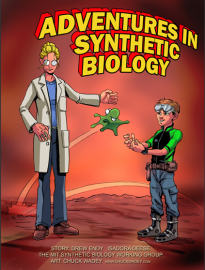 File:Adventures1.png File:Adventures3.png
File:Adventures1.png File:Adventures3.png
The New York Times recently published an article on the perils of powerpoint, highlighting the case of [http://www.nytimes.com/2010/04/27/world/27powerpoint.html?hp this mindmap of American military strategy], though highly complex, it tells the story... The team quickly drew a map of the key characters in synbio. More on this soon!
Now, its back to biobricks and time to map out this morning's presentations with biobricks and design experiments to describe the concepts.
Thursday 24th June: Playing Gods
Playing Gods - we're looking for an alternative mythology to build synbio on.
Deepening Knowledge
Before the scientific presentations of the concepts, some more research...
James' article about different versions of synbio http://seedmagazine.com/content/article/slippery_cellularities/
Daisy's article about design and synbio http://www.designindaba.com/article/form-and-multiply
Daisy and Oron Catt's fiction about a dystopian synbio future:
![]()
Critical Time Magazine article http://www.time.com/time/magazine/article/0,9171,1997447,00.html?xid=rss-topstories
Collection made by RCA students of videos and talks: http://beta.interaction.rca.ac.uk/synbio/?page_id=23
Long Now Debate about Synbio http://fora.tv/2008/11/17/Drew_Endy_and_Jim_Thomas_Debate_Synthetic_Biology
Venter at Ted http://www.ted.com/talks/view/id/227
Venter talking to Designers http://www.designindaba.com/speaker/video/j-craig-venter-designing-science
Total buys 17% stake in Amyris http://www.total.com/en/about-total/news/news-940500.html&idActu=2402
The Presentations...
The Holy Trinity
Soma
Image to come...
Lead me to Light Image to come...
Level 10 Comics
Suhas and Deepak from Level 10 comics came to inspire us and learn about synbio. They've started up an awesome comic company that makes dystopian comics set in India, inspired by mythologies... The Rabhas incident is our favourite, a gory zombie-fest set in modern-day Bangalore, its iconic buildings and streets all-too recognizable. We introduced synbio, then learnt about the process and decisions in making comics. Very, very inspiring afternoon.
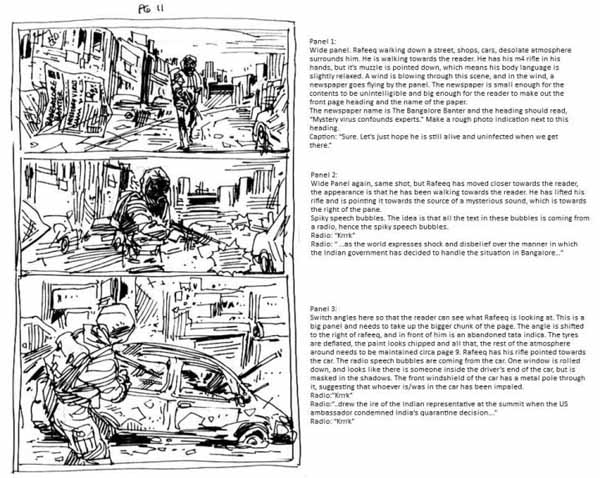 File:24117 374614647252 371500427252 3738901 4359625 n.jpg
Images from [http://www.facebook.com/l/0faf6;scienceblogs.com/worldsfair/2008/01/synthetica_a_new_continent_of.php#!/photo.php?pid=3725111&id=371500427252&fbid=374016367252 The Rabhas Incident]
File:24117 374614647252 371500427252 3738901 4359625 n.jpg
Images from [http://www.facebook.com/l/0faf6;scienceblogs.com/worldsfair/2008/01/synthetica_a_new_continent_of.php#!/photo.php?pid=3725111&id=371500427252&fbid=374016367252 The Rabhas Incident]
The Clearing
In the evening, another method of storytelling about science. We went to see [http://www.theatrescience.org.uk/ee/index.php/news/view/human_and_ecological_invasions_intertwine_in_the_clearing_this_week/ The Clearing] by Gautam Raja, a play about invasive species. "The Clearing evolved from the month-long Theatrescience residency at the National Centre for Biological Sciences (NCBS) in January 2009, and is based on scientific input from Dr. Suhel Qader relating to “causes and consequences of invasions: the ecology and evolution of invasive species”, with additional information from the NGO Ashoka Trust for Research in Ecology and the Environment (ATREE)."
The story focuses on the spread of Lantana, a plant introduced by the British as an ornamental plant, is said to be one of the world's most invasive weeds, now dominating up to 60% of the forest floor in some places. A production by ART - a Bangalore-based theatre group in collaboration with TheatreScience, a UK-based organisation.
"Lantana, said to be one of the world’s most invasive weeds, lurks in the background as a character in this play, set in the forests of South India. The behaviour of floral invasive species has parallels with that of human invaders, and ‘The Clearing’ is a play about invasions, intended or otherwise. Ramesh is a scientist studying lantana, who needs to do lengthy fieldwork in the forest. His wife, Vinita, accompanies him and finds, to her interest, an NGO that teaches forest dwellers to make furniture from lantana. Being a graphic designer, she has her own ideas about designs and marketing, which unsettles Roshni, her former schoolmate and an NGO worker. The two tribal forest dwellers, Marappa and his daughter Shanti, have big dreams, but there’s so much that’s out of their control."
Friday 25th June: Future Myths
Samrajni
- America, Obama, CIA, Funding, NIH
Nooshin
- Venter, Synthetic Genomics
Anousha
- Jay Keasling, Energy Industry (BP, TOTAL, SHELL etc…)
Farhad
- Bioethicists, Hastings Centre, LSE BIOS Centre, ETC Group
Diya
- Drew Endy
Karthik
- Singularitarians, Transhumanists, Humanity + conference in Boston
Aaron
- Designers
Akshitta
- George Church
Shreya
- Monsanto
Mohor
- India
Monday 28th June: Altogether Now
Playing Gods: New Myths for Synthetic Biology
Team Work
Tuesday 29th June: A Critical Stance
On a weekend trip to Ahmedabad, I picked up a postcard from the bookshop at the [http://en.wikipedia.org/wiki/Sabarmati_Ashram Sabarmati Ashram]. The front has a picture of Gandhi staring down a microscope, the back the following quote:
"I would like to pay my tribute to the spirit that fires the modern scientist. My quarrel is not against that spirit. My complaint is against the direction that spirit has taken." MK Gandhi, The Health Guide
One of the attitudes that we would like to instill in the team is to take a critical stance when faced with the ideas and achievements of synthetic biology. What direction is the field taking as a whole? Who's vision is driving it? Is the vision realistic, or pure fantasy? Who will benefit from the technology? A critical stance will help the team to build their own vision for synthetic biology which they can then go on to communicate at the iGEM Jamboree. Perhaps they could communicate it as a [http://www.youtube.com/watch?v=V112pTo--Js song].
Codex Seraphinianus
The [http://en.wikipedia.org/wiki/Codex_Seraphinianus Codex Seraphinianus], by Luigi Seraphini is a book about an imaginary place written in a language that no-one can understand. It is a richly illustrated account of the nature and culture of this land. In the pages of the book, every assumption about how the world works has been turned on its head. A similar questioning attitude is useful when imagining what might be biologically possible. We are used to the idea that some organisms reproduce in pairs creating one or more offspring that inherit the genetic material of their parents. Could we imagine a biology where things work differently?
Navarasam
Avni gave a presentation to the Students about the concept of 'Navarasam' or the 9 emotional states.
Being a performing artist, the continuous effort one makes is to live the performance in every single moment, in the everyday and in the mundane. It seems to be a great way to live - sans duality. I was wondering how the same ethos can be translated into synthetic biology. Navarasam - the (all encompassing) 9 emotions is one such phenomena, it represents how one experiences life.
The team was probed into imagining synthetic biology as an extension of their everyday experiences. Parallely, they have their training in art and design, which equips them in creating matter and therefore telling stories through these artifacts. How about extending this experience of synthetic biology into an artifact. Artistic yet commercial? Critical yet naive?
Wednesday 30th June: Thinking about Ecosystems
One of the topics that has kept on coming up during the course of the workshop has been the subject of designing ecosystems. In contrast to the quest for the [http://www.ncbi.nlm.nih.gov/pubmed/16924266 minimal cell] that epitomizes synthetic biology's quest for a rational, predictable biology, the design of ecosystems requires a completely different approach.
Yashas came across a chapter in a [http://www.kk.org/outofcontrol/ch8-f.html book] by Kevin Kelly about designing Synthetic Ecosystems. Here's a quote, the sentiment very much echoes in the discussion that we had after watching The Clearing last week.
"We might as well develop a science of synthetic ecosystem creation since we've been creating them anyway in a haphazard fashion. Many archeo- ecologists believe that the entire spectrum of early humanoid activities -- hunting, grazing, setting prairie fires, and selective herb gathering -- forged an "artificial" ecology upon the wilderness, that is, an ecology greatly shaped by human arts. In fact, all that we think of as natural virgin wilderness is abundant with artificiality and the mark of human activity."
Kelly then lists a number of considerations when designing an ecosystem intentionally:
- Microorganisms do most of the work.
- Soil is an organism. It is alive. It breathes.
- Make redundant food webs.
- Increase diversity gradually.
- If you can't provide a physical function, you need to simulate it.
- The atmosphere communicates the state of the whole system.
- Listen to the system; see where it wants to go.
What would it mean to design an ecosystem in the context of iGEM. For one thing, it would have to be a self-contained, as it wouldn't be possible to release GM organisms in the wild. A bacterial ecosystem might be the best place to start.
Most of the lab techniques and protocols that deal with cloning and culturing bacteria are designed to keep everything as sterile as possible. We deal with mono-cultures of a specific bacteria, grown in an antibiotic environment to avoid contamination. However there are techniques that have been developed to study 'multicultural' ecosystems. The [http://en.wikipedia.org/wiki/Winogradsky_column Winogradsky Column] is a tool to grow multiple type of bacteria across a simulution of a more natural bacterial environment.
We asked the students to build a widowgradsky column, Jugaad-style.
It will take several weeks before anything interesting happens as the development of a natural ecosystem is a slow process (another interesting thing to consider when attempting to design one!).
In the meantime, the students have been thinking about how they might like to develop this idea further, perhaps towards their iGEM competition entry. Here's an idea from Karthik. It asks the question of whether a bacterial ecosystem could be designed to act like a multi-cellular organism:
Karthik came up with the idea of a moving eye: an enclosed glass vessel containing synthetic bacteria, floating on water.In the centre of the vessel is a colony of light sensitive bacteria on the surface of a glass cup - actually an artificial eye. When the light hits these bacteria they trigger one of four different colonies to start producing a gas. This would then exit the vessel, pushing it in the direction of the light source. What other synthetic multicellular organisms could we make?
Thursday 1st July: To the lab!
Today was our first day in the lab. We picked up the biobricks from the freezer at Srishti and headed to our lab at NCBS.
 "
"

